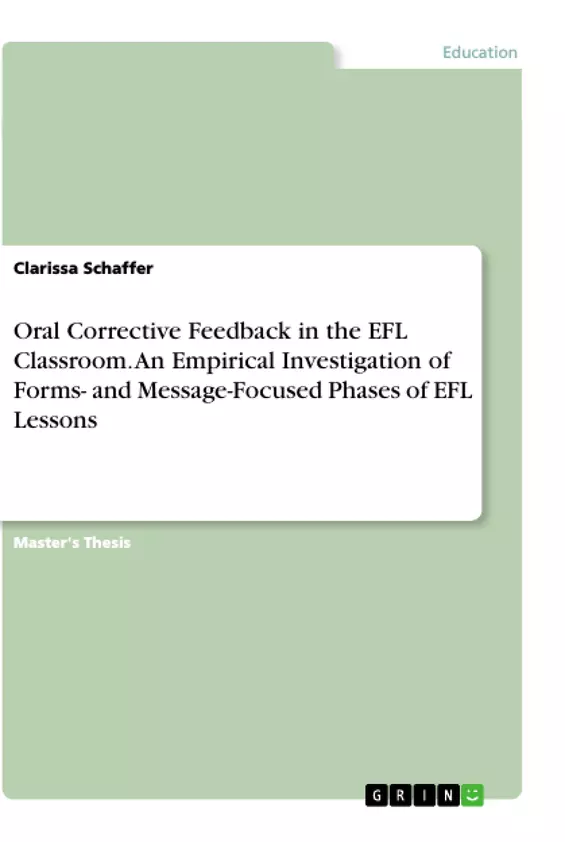This master thesis examines the research question "In how far is oral corrective feedback given in forms- and message-focused phases in the EFL classroom?" and is based on observations of three classes in year 5, three classes in year 7 and three classes in year 10 (10 h each). Information is given on the following sub-research questions:
To what extent does oral corrective feedback take place in forms- and message-focused phases?
What types of OCF are used in forms- and message-focused phases?
To what extent does OCF take place in classes of younger EFL learners and in classes of older EFL learners in forms- and message-focused phases?
What types of OCF are used concerning students of different ages in forms- and messagefocused phases?
To what extent do teacher preferences concerning different OCF types exist in forms- and message-focused phases?
“The greatest mistake you can make in life is to be continually fearing you will make one” (Hubbard, 1927). This statement does not only refer to the behaviour of many people in their daily lives, it does also especially refer to students in English as a foreign language (EFL) classrooms who rather do not participate during lessons than risk making an error or a mistake as they are afraid of losing their face (cf. Decke-Cornill & Küster, 2015). However, errors and mistakes are of high importance from a diagnostic point of view as they hint at the current level of students, their course of the learning process, their success or failure of their learning strategies as well as what type of support they might need (cf. Kieweg, 2007; Vetter, 2007; Haß, 2017). And even further, students are also in need of feedback to check their own ability in the foreign language and not to consolidate erroneous grammatical structures, vocabs or an incorrect pronunciation (cf. Timm, 2009). Hence, whenever an oral error or mistake occurs in the EFL classroom, teachers have to deal with the situation by deciding whether the specific error or mistake should be corrected or not and if so, how it should be corrected to support the learning process of the student without inhibiting him or her on an emotional level. Therefore, the topic of oral corrective feedback (OCF) is relevant for all EFL teachers and their daily practice in class.
Inhaltsverzeichnis (Table of Contents)
- 1 Introduction
- 2 Theoretical Background
- 2.1 Oral Linguistic Errors and Mistakes and Different Error Types
- 2.2 Types of Oral Corrective Feedback
- 2.3 Factors which Influence the Treatment of OCF in the English Foreign Language Classroom
- 2.3.1 Phases of a Lesson
- 2.3.2 Oral Corrective Feedback Concerning Different Ages of the Learners
- 2.3.3 Teacher Preference Concerning OCF Types
- 2.4 Research Question and Hypotheses
- 3 Methodology
- 3.1 Informants of the Study and the Data Collection Procedure
- 3.2 The Employed Research Instrument
- 3.3 Data Handling
- 3.4 Methodological Strengths and Limitations
- 4 Results
- 4.1 The Extent of OCF Concerning Different Error Types in Forms- and Message-Focused Phases of a Lesson
- 4.2 The Usage of Different Feedback Types in Forms- and Message-Focused Phases of a Lesson
- 4.3 The Extent of OCF Concerning Different Ages of the Students in Forms- and Message-Focused Phases of a Lesson
- 4.4 The Usage of Different Feedback Types Concerning Different Ages of the Students in Forms- and Message-Focused Phases of a Lesson
- 4.5 The Extent of Teacher Preferences Concerning Different OCF Types in Forms- and Message- Focused Phases of a Lesson
- 5 Discussion
- 5.1 The Extent of OCF Concerning Different Error Types in Forms- and Message-Focused Phases of a Lesson
- 5.2 The Usage of Different Feedback Types in Forms- and Message-Focused Phases of a Lesson
- 5.3 The Extent of OCF Concerning Different Ages of the Students in Forms- and Message- Focused Phases of a Lesson
- 5.4 The Usage of Different Feedback Types Concerning Different Ages of the Students in Forms- and Message-Focused Phases of a Lesson
- 5.5 The Extent of Teacher Preferences Concerning Different OCF Types in Forms- and Message- Focused Phases of a Lesson
Zielsetzung und Themenschwerpunkte (Objectives and Key Themes)
This master's thesis examines the use of oral corrective feedback (OCF) in the English as a Foreign Language (EFL) classroom. The research aims to investigate the extent of OCF concerning different error types, ages of students, and teacher preferences in forms- and message-focused phases of EFL lessons. The study also explores the usage of different feedback types in these phases.
- The use of oral corrective feedback (OCF) in EFL lessons.
- The influence of error types on the implementation of OCF.
- The impact of students' age on the application of OCF.
- Teacher preferences regarding different types of OCF.
- The role of lesson phases (forms-focused and message-focused) in the use of OCF.
Zusammenfassung der Kapitel (Chapter Summaries)
Chapter 1 introduces the research topic and provides background information on oral corrective feedback in EFL classrooms. Chapter 2 presents a comprehensive theoretical framework, exploring different error types, types of OCF, factors influencing OCF implementation, and research questions and hypotheses. Chapter 3 outlines the research methodology, including the data collection procedure, research instrument, data handling, and methodological strengths and limitations. Chapter 4 presents the results of the study, focusing on the extent of OCF concerning different error types, ages of students, and teacher preferences in forms- and message-focused phases of lessons. The chapter also examines the usage of different feedback types in these phases.
Schlüsselwörter (Keywords)
This study focuses on oral corrective feedback (OCF), EFL classroom, error types, feedback types, lesson phases, student age, teacher preferences, forms-focused, message-focused, empirical research.
- Citation du texte
- Clarissa Schaffer (Auteur), 2019, Oral Corrective Feedback in the EFL Classroom. An Empirical Investigation of Forms- and Message-Focused Phases of EFL Lessons, Munich, GRIN Verlag, https://www.grin.com/document/917574



